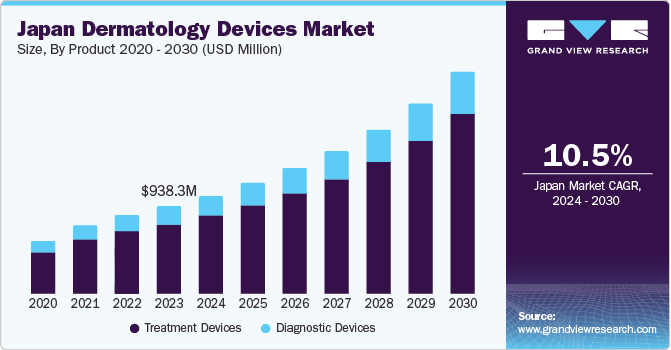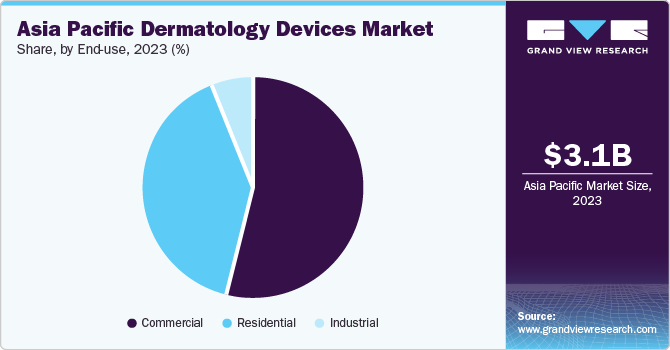- Home
- »
- Medical Devices
- »
-
Asia Pacific Dermatology Devices Market Size, Report, 2030GVR Report cover
![Asia Pacific Dermatology Devices Market Size, Share & Trends Report]()
Asia Pacific Dermatology Devices Market Size, Share & Trends Analysis Report By Product (Diagnostic Devices, Treatment Devices), By End Use (Hospitals, Clinics, Others), By Country, And Segment Forecasts, 2024 - 2030
- Report ID: GVR-4-68040-311-5
- Number of Report Pages: 80
- Format: PDF, Horizon Databook
- Historical Range: 2018 - 2023
- Forecast Period: 2024 - 2030
- Industry: Healthcare
Market Size & Trends
The Asia Pacific dermatology devices market size was estimated at USD 3.1 billion in 2023 and is projected to grow at a CAGR of 14.3% from 2024 to 2030. The market growth is primarily driven by the increasing prevalence of skin disorders in the region. As awareness about skin health grows, individuals seek effective solutions for various skin issues, ranging from acne to skin cancer. In addition, technological advancements have led to the development of innovative devices that offer precise diagnostics, targeted treatments, and improved patient outcomes. Furthermore, rising disposable incomes and a growing middle-class population in countries like China and India contribute to the market's expansion.

The Asia Pacific dermatology devices market accounted for a share of 20.3% of the global dermatology devices market revenue in 2023. Country-specific regulations across the region significantly influence the market. For instance, in Japan, manufacturers must obtain SHONIN (marketing approval) from the Pharmaceuticals and Medical Devices Agency (PMDA) before commercializing their products. In China, companies must register their dermatology devices and obtain the Medical Device Registration Certificate based on the Classification Catalogue of Medical Devices.
India's Central Drugs Standard Control Organization (CDSCO) regulates safety and efficacy standards for dermatology devices. South Korea's Ministry of Food and Drug Safety (MFDS) requires MFDS approval to sell such devices. The Health Sciences Authority (HSA) oversees regulations in Singapore, and companies must obtain HSA approval for dermatology devices. These regulatory frameworks impact product development, market access, and patient safety, shaping the dynamic Asia Pacific dermatology devices market.
Product Insights
The treatment devices segment captured a revenue share of 80.2% in 2023 and is projected to grow rapidly during the coming years. This dominance is attributed to the rising demand for procedures addressing common concerns like acne, wrinkles, and unwanted hair. Furthermore, technological advancements in lasers, cryotherapy, and liposuction devices are improving treatment efficacy and safety, further propelling the segment growth.
The diagnostic devices segment is estimated to register the fastest CAGR of 13.3% from 2024 to 2030. This growth is fuelled by the increasing awareness of skin cancer and other skin conditions and the development of more precise and noninvasive diagnostic tools like dermoscopes and confocal microscopy. These advancements allow for earlier and more accurate diagnoses, ultimately leading to better patient outcomes.
End-use Insights
The hospitals segment held the largest share of 54.4% of the overall revenue in 2023 as hospitals are equipped with a wider range of advanced dermatology devices, including sophisticated imaging systems for skin cancer diagnosis, complex laser treatments for various conditions, and surgical tools for more invasive procedures. The presence of specialized dermatology departments within hospitals attracts patients with complex or severe skin conditions requiring the expertise and comprehensive facilities hospitals offer.

The clinics segment, on the other hand, is predicted to grow at the fastest CAGR of 15.3% over the forecast period. The growing disposable income in countries across the region is expected to augment the demand for aesthetic procedures, which are often performed in clinics. The increasing focus on preventative healthcare encourages patients to seek early intervention for skin concerns, leading them to visit clinics for consultations and treatment.
Country Insights
Japan Dermatology Devices Market Trends
The Japan dermatology devices marketheld the largest share of 30.7% of the total revenue in 2023. The market’s prominence can be attributed to Japan’s well-established healthcare infrastructure, including advanced dermatology clinics and hospitals. The population’s high awareness of skincare and beauty consciousness drives demand for noninvasive cosmetic treatments. In addition, technological advancements in imaging devices, such as dermoscopes and high-resolution diagnostic tools, have contributed to accurate skin cancer diagnosis and efficient follow-up after surgery.
India Dermatology Devices Market Trends
The dermatology devices market in Indiais predicted to grow at a CAGR of 15.4% from 2024 to 2030 owing to India’s large population, coupled with rising disposable income. The adoption of Artificial Intelligence (AI) for diagnosing skin disorders is gaining traction in India. AI-powered tools enable effective diagnosis of conditions such as acne, psoriasis, and rosacea.
Key Asia Pacific Dermatology Devices Company Insights
Some of the key players operating in the market include Maruho Co., Candela Corp., and Alma Lasers GmbH:
-
Maruho Co., Ltd. is a manufacturer of medical devices, including those for dermatology applications. Its focus areas include lasers for hair removal and scar treatment
-
Sinclair Pharma is an Australian pharmaceutical and aesthetics company with a portfolio of dermatology devices for conditions, such as acne and rosacea
Key Asia Pacific Dermatology Devices Companies:
- Alma Lasers
- Candela Corporation
- Cutera Inc.
- Maruho Co., Ltd.
- FotoFinder Systems GmbH
- Leica Microsystems
- Lumenis
- Allergan Plc
- Merz Pharma
- Sinclair Pharma
Recent Developments
-
In November 2023, Alma Lasers, a leading provider of energy-based medical and aesthetic solutions, expanded its APAC presence by opening a new subsidiary in Japan, solidifying its position as a major player in the region's growing medical aesthetics market
-
In September 2023, DERM licensed Qbrexza (glycopyrronium tosylate hydrate) to Maruho Co., Ltd. for development and commercialization in specific Asian markets for treating hyperhidrosis
Asia Pacific Dermatology Devices Market Report Scope
Report Attribute
Details
Revenue forecast in 2030
USD 7.9 billion
Growth rate
CAGR of 14.3% from 2024 to 2030
Base year for estimation
2023
Forecast period
2024 - 2030
Quantitative units
Revenue in USD million/billion and CAGR from 2024 to 2030
Report coverage
Value & revenue forecast, competitive landscape, growth factors, trends
Segments covered
Product, end-use, country
Country scope
Japan; China; India; Australia; South Korea; Indonesia; Malaysia; Singapore; Thailand; Philippines
Key companies profiled
Alma Lasers; Candela Corp.; Cutera Inc.; Maruho Co., Ltd.; FotoFinder Systems GmbH; Leica Microsystems; Lumenis; Allergan Plc; Merz Pharma; Sinclair Pharma
Customization scope
Free report customization (equivalent to up to 8 analysts working days) with purchase. Addition or alteration to country, regional & segment scope.
Pricing and purchase options
Avail customized purchase options to meet your exact research needs. Explore purchase options
Asia Pacific Dermatology Devices Market Report Segmentation
This report forecasts revenue growth at regional and country levels and provides an analysis of the latest trends in each of the sub-segments from 2018 to 2030. For this study, Grand View Research has segmented the Asia Pacific dermatology devices market report based on product, end-use, and country:
-
Product Outlook (Revenue, USD Billion, 2018 - 2030)
-
Diagnostic Devices
-
Dermatoscope
-
Microscopes
-
Other Imaging Devices
-
Biopsy Devices
-
-
Treatment Devices
-
Light Therapy Devices
-
Lasers
-
Electrosurgical Equipment
-
Liposuction Devices
-
Microdermabrasion Devices
-
Cryotherapy Devices
-
-
-
End-use Outlook (Revenue, USD Billion, 2018 - 2030)
-
Hospitals
-
Clinics
-
Others
-
-
Country Outlook (Revenue, USD Billion, 2018 - 2030)
-
Japan
-
China
-
India
-
Australia
-
South Korea
-
Indonesia
-
Malaysia
-
Singapore
-
Thailand
-
Philippines
-
Share this report with your colleague or friend.
![gvr icn]()
NEED A CUSTOM REPORT?
We can customize every report - free of charge - including purchasing stand-alone sections or country-level reports, as well as offer affordable discounts for start-ups & universities. Contact us now
![Certified Icon]()
We are GDPR and CCPA compliant! Your transaction & personal information is safe and secure. For more details, please read our privacy policy.
We are committed towards customer satisfaction, and quality service.
"The quality of research they have done for us has been excellent."





